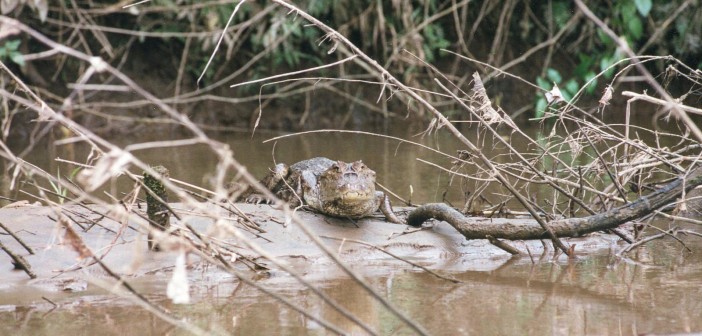(Featured image: caiman in Costa Rica (not Josefina). Credit Kim Bartlett – Animal People)
In October 2001, Animal People traveled to Costa Rica to attend a conference hosted by the National College of Veterinarians, featuring an animal welfare program organized by Dr. Yayo Vicente of the McKee Project. Following the conference, we traveled to several other parts of Costa Rica, including a rainforest close to the country’s northern border, where Rio San Carlos meets Rio San Juan, which forms the border between Costa Rica and Nicaragua.
The Laguna del Lagarto Lodge, where we stayed for two nights, wasn’t as primitive as the places we stayed at in the Amazon a couple years prior. There was electricity and even hot running water. And there was a road to get to it instead of having to take a boat up the river. The rainforest itself looked much the same, except that there were many fewer animals. Contrary to what people are led to believe by mainstream environmentalists, other than insects and birds there aren’t that many animals in the rainforest. At best, it is a very thin ecosystem on the ground. There may be a great “diversity” of species in a large rainforest – meaning that it may contain members of many different species – but there will be very few individuals of any mammalian species per square mile of rainforest. There were two large Dobermans living at the lodge, and they were allowed to run loose in the forest. Since there was such a slim chance of meeting up with a big cat, the greatest danger to the dogs would be poisonous snakes.
The most noticeable difference between the Amazon rainforest and where we were in Costa Rica were the butterflies. There were abundant butterflies in the Amazon, of all sizes and colors, including the big and bright blue morpho butterflies. There were relatively few in Costa Rica. I think we saw more leaf-cutter ants there than any other kind of insect. Walking through the forest there, we hardly saw any animals, but in the clearings around the lodge, there were toucans, hummingbirds, and a few parrots. We saw other species of birds on a river boat trip on the second day. We also saw howler monkeys along the river and a chained-up “pet” spider monkey at a little village by the customs house at the Costa Rica-Nicaragua border.
Surprisingly, the creatures in and along the river and in the lagoon around the lodge who seemed most numerous and actually most interesting were the crocodiles and caiman. The lodge lagoon was full of caiman, who are actually a kind of small alligator. This is not exactly good eco-policy, but at night after dinner, lodge employees would feed the caimans for the excitement of the guests. Mostly the caimans were fed scraps of meat. After dinner, lodge guests could trudge down the hill to the lagoon where the night watchman or lodge cook would wave a flashlight and call the caimans by name: “Charlie” first, and then “Mommy,” “Baby,” and “Josefina.” These reptiles knew their names and would come out of the lagoon to get their treats. The first night, Josefina came late and all the food was gone. But the second night, Josefina was not to be left out. As soon as she heard the names of the other caiman being called, she got out of the water at her usual place and rushed down the road to Charlie’s usual spot.
It was a little scary to see this alligator rushing towards us out of the dark, but she showed surprising restraint in stopping about ten feet from us instead of barreling into the group. She seemed to know we would feel threatened by her, and she stopped at a respectful distance, hoping that the man handing out the food would bring her a share. She was prepared to wait patiently.
As it turned out, the meat was all gone before she got there, the second night in a row. Everyone agreed that it was really unfair, and someone went to the kitchen to find her something. He brought back hot dogs. Now Josefina had never seen a hot dog before and found it hard to eat them from the ground. She wasn’t able to get them in her mouth. So the lodge naturalist, who had a walking stick, got very close to her and used the stick to knock the hot dogs into a position where she could bite them. She clearly understood what he was doing, that he was trying to help her eat. Her intelligence was obvious.
Reptiles are not thought of as being responsive, or being particularly intelligent. Josefina’s display of intelligence was amazing, but more amazing was her display of sensitivity to what we humans were doing and to the effect she was having on us.








1 Comment
A really lovely story! And yes, reptiles, including snakes, are just as intelligent as mammals — and so are fish, by the way.